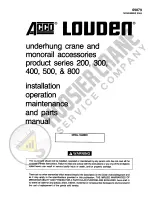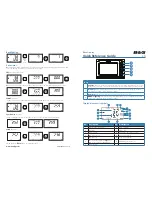
STYLE 4446 SELECTABLE FLOW NOZZLE
INSTALLATION, OPERATING, AND MAINTENANCE INSTRUCTIONS
PHONE: 330.264.5678 or 800.228.1161 I FAX: 330.264.2944 or 800.531.7335
www.akronbrass.com
Sheet: 127253
Revision: 06/2019
Page: 2 of 3
•
Indicates a hazardous situation which, if not avoided, WILL result in death or serious injury.
•
Indicates a hazardous situation which, if not avoided, COULD result in death or serious injury.
•
Indicates a potentially hazardous situation which, if not avoided, may result in minor or moderate
injury.
•
Addresses practices not related to personal injury.
•
Not for use on electrical fires.
•
Charge all lines slowly to facilitate a controlled water pressure build-up during start-up. Open and
close slowly. Rapid opening will produce a sudden thrust. Rapid opening and closing can cause
water hammer. Have enough firefighters on the line to safely control the reaction force created by
the stream.
•
At pressures below that indicated on the label, the nozzle will have reduced flow and reach. Be sure
you have enough flow and pressure for the situation (See IFSTA and NFPA manuals for guidelines).
•
The amount of flow to a nozzle is controlled at the pump, not at the nozzle. Therefore, unanticipated
increases and decreases in flow can occur without the knowledge of the nozzle operator. This can
cause serious consequences (i.e. too little flow to extinguish the fire, or increased reaction force
which the nozzle operator may be unable to handle).
•
Do not use the nozzle in portable hose holders.
•
Ensure the nozzle is aimed in a direction that is safe.
•
Ensure the thread on the nozzle swivel is matched to the thread on the monitor connection.
•
Do not use the nozzle as a shut-off when testing hose.
•
When operating at lower pressures the hose can kink more easily. A kink in the hose chokes off the
flow, which may result in inadequate flow for the situation.
•
Your nozzle should be inspected prior to and after each use, to ensure it is in good operating
condition. Periodically, an unanticipated incident may occur where the nozzle is used in a manner
that is inconsistent with standard operating practices and those listed in IFSTA. A partial list of
potential misuses follows:
• Operating above maximum rated pressure and flow.
• Not draining, and allowing water to freeze inside the nozzle.
• Dropping the nozzle from a height where damage is incurred.
• Prolonged exposure to temperatures above +130 degrees F, or below -25 degrees F.
• Operating in a corrosive environment.
• Other misuse that might be unique to your specific fire fighting environment.
•
There are many “tell tale” signs that indicate nozzle repair is in order, such as:
• Controls that are inoperable or difficult to operate.
• Excessive wear.
• Poor discharge performance.
• Water leaks.
If any of the above situations are encountered, the nozzle should be taken out of service and
repaired, plus tested by qualified nozzle technicians, prior to placing it back in service.
•
Do not use the nozzle as a forcible entry tool. Doing so may damage it or make it inoperable.
•
If any tags or bands on the nozzle are worn or damaged and cannot be easily read, they should be
replaced.
•
For use with fresh water or standard firefighting foams only. Not recommended for use with salt
water. After use with foam or salt water, flush with fresh water.





















